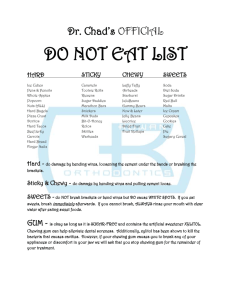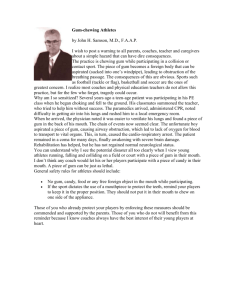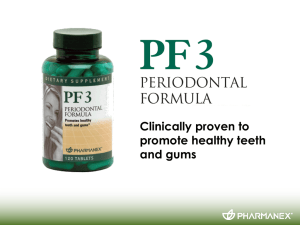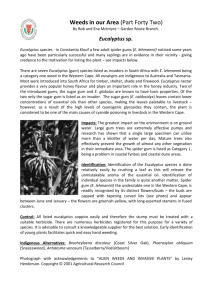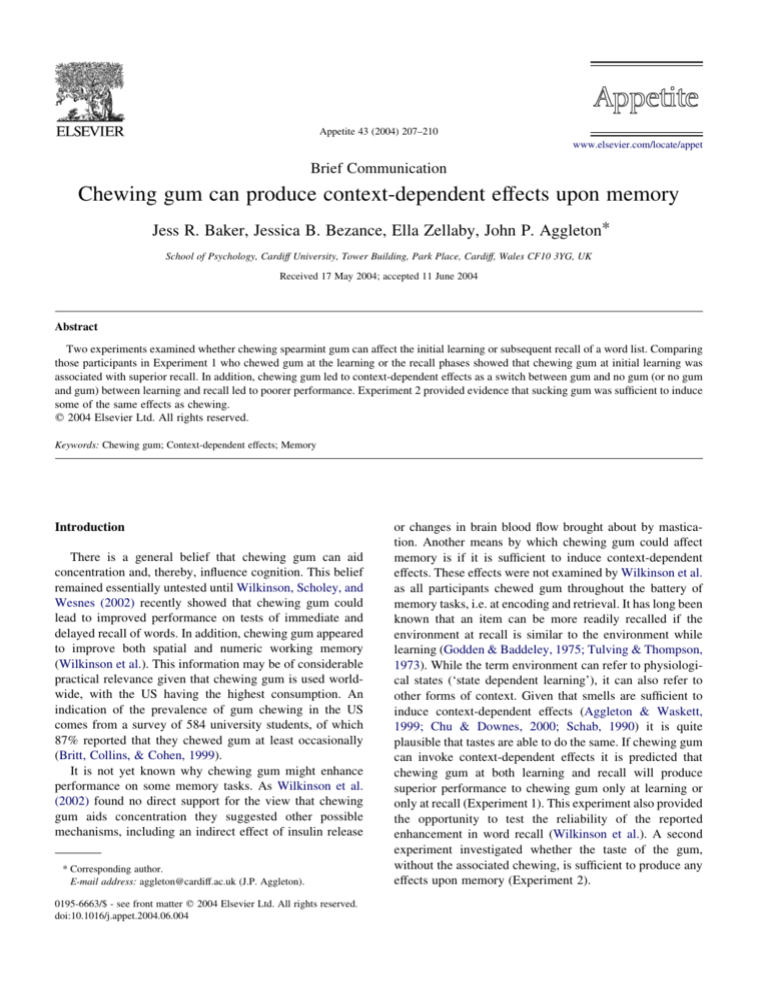
Appetite 43 (2004) 207–210
www.elsevier.com/locate/appet
Brief Communication
Chewing gum can produce context-dependent effects upon memory
Jess R. Baker, Jessica B. Bezance, Ella Zellaby, John P. Aggleton*
School of Psychology, Cardiff University, Tower Building, Park Place, Cardiff, Wales CF10 3YG, UK
Received 17 May 2004; accepted 11 June 2004
Abstract
Two experiments examined whether chewing spearmint gum can affect the initial learning or subsequent recall of a word list. Comparing
those participants in Experiment 1 who chewed gum at the learning or the recall phases showed that chewing gum at initial learning was
associated with superior recall. In addition, chewing gum led to context-dependent effects as a switch between gum and no gum (or no gum
and gum) between learning and recall led to poorer performance. Experiment 2 provided evidence that sucking gum was sufficient to induce
some of the same effects as chewing.
q 2004 Elsevier Ltd. All rights reserved.
Keywords: Chewing gum; Context-dependent effects; Memory
Introduction
There is a general belief that chewing gum can aid
concentration and, thereby, influence cognition. This belief
remained essentially untested until Wilkinson, Scholey, and
Wesnes (2002) recently showed that chewing gum could
lead to improved performance on tests of immediate and
delayed recall of words. In addition, chewing gum appeared
to improve both spatial and numeric working memory
(Wilkinson et al.). This information may be of considerable
practical relevance given that chewing gum is used worldwide, with the US having the highest consumption. An
indication of the prevalence of gum chewing in the US
comes from a survey of 584 university students, of which
87% reported that they chewed gum at least occasionally
(Britt, Collins, & Cohen, 1999).
It is not yet known why chewing gum might enhance
performance on some memory tasks. As Wilkinson et al.
(2002) found no direct support for the view that chewing
gum aids concentration they suggested other possible
mechanisms, including an indirect effect of insulin release
* Corresponding author.
E-mail address: aggleton@cardiff.ac.uk (J.P. Aggleton).
0195-6663/$ - see front matter q 2004 Elsevier Ltd. All rights reserved.
doi:10.1016/j.appet.2004.06.004
or changes in brain blood flow brought about by mastication. Another means by which chewing gum could affect
memory is if it is sufficient to induce context-dependent
effects. These effects were not examined by Wilkinson et al.
as all participants chewed gum throughout the battery of
memory tasks, i.e. at encoding and retrieval. It has long been
known that an item can be more readily recalled if the
environment at recall is similar to the environment while
learning (Godden & Baddeley, 1975; Tulving & Thompson,
1973). While the term environment can refer to physiological states (‘state dependent learning’), it can also refer to
other forms of context. Given that smells are sufficient to
induce context-dependent effects (Aggleton & Waskett,
1999; Chu & Downes, 2000; Schab, 1990) it is quite
plausible that tastes are able to do the same. If chewing gum
can invoke context-dependent effects it is predicted that
chewing gum at both learning and recall will produce
superior performance to chewing gum only at learning or
only at recall (Experiment 1). This experiment also provided
the opportunity to test the reliability of the reported
enhancement in word recall (Wilkinson et al.). A second
experiment investigated whether the taste of the gum,
without the associated chewing, is sufficient to produce any
effects upon memory (Experiment 2).
208
J.R. Baker et al. / Appetite 43 (2004) 207–210
Experiment 1: chewing gum as a context change
Methods
Participants comprised an opportunity sample of 83
undergraduates from Cardiff University (57 females), with
an age range from 18 to 46 years (mean 24). Participants
were randomly assigned to one of four conditions, which
refer to whether they were asked to chew gum (or not) at the
time of learning or at the time of recall: gum (learning)–gum
(recall) (nZ23), gum–no gum (nZ20), no gum–gum (nZ
20), and no gum–no gum (nZ20). In all gum conditions
participants were given Wrigley’s Extra spearmint chewing
gum, sugar free (Wm. Wrigley Jr. Company, Chicago, IL).
All participants were tested individually on their ability
to learn a list of 15 words printed on a single sheet of paper.
Participants were told that they had 2 min to learn as many
of the words as possible. Recall was tested at the end of the
2 min and again 24 h later. The 15 words were matched for
concreteness and imagery (Paivio, Yuille, & Madigan,
1968). Participants in the conditions where gum chewing
occurred during learning (gum–gum, gum–no gum) were
given the gum to chew prior to receiving the word list.
Participants in the no gum–gum condition were given gum
to chew immediately after the 2 min learning period, and
asked to chew throughout the recall period. Participants
were told in advance whether they would have to remove
gum (gum–no gum group) or start to chew gum (no gum–
gum) immediately after initial learning. Those participants
in the gum at recall groups (gum–gum, and no gum–gum)
were again given gum to chew 24 h later, immediately prior
to recall. All participants were given 2 min to write down as
many of the 15 words that they could remember.
Results
Fig. 1 shows the mean scores for the four conditions for
the two retention intervals. The first question (can chewing
gum induce context-dependent effects?) was tested by
comparing the scores of the two context change groups
(gum–no gum, no gum–gum) with the scores of the two
consistent groups (gum–gum, no gum–no gum). An
ANOVA using data from both recall tests showed that the
consistent groups had significantly higher recall scores
F(1,81)Z5.96, pZ0.017. This comparison also revealed a
highly significant group by retention interval interaction,
F(1,81)Z29.2, p!0.0001, reflecting the steeper decline in
performance in the two inconsistent groups. Analysis of the
simple effects (Winer, 1971) showed that there was a group
difference at the 24 h delay, F(1,114)Z20.04, p!0.001, but
not at immediate recall F!1.
The second question (can chewing gum enhance initial
learning?) can be considered by comparing the two groups
that chewed gum at initial learning (nZ43) with the two
groups that did not (nZ40). An ANOVA using data from
both recall sessions found higher scores for those chewing
gum at encoding, F(1,81)Z5.72, pZ0.019, as well as a
significant interaction with recall session, F(1,81)Z7.73,
pZ0.0068. This interaction reflected the lack of a group
difference for immediate recall F!1, which contrasted with
a clear difference after 24 h, F(1,121)Z11.5, pZ0.001.
Evidence that chewing gum can aid learning was still
found when the comparisons were restricted to conditions
matched for whether there was or was not a context shift.
For the constant context groups, the gum–gum group had
higher overall scores than the no gum–no gum group
F(1,41)Z7.25, pZ0.010. There was a clear superiority for
the gum–gum group at the 24 h delay, F(1,54)Z9.36, pZ
0.003, but a less marked difference for the immediate
condition F(1,54)Z3.70, pZ0.06. While there was no
overall difference between the gum–no gum and no gum–
gum conditions (F!1), there was a group by delay
interaction, F(1,38)Z7.96, pZ0.0076. This interaction
(Fig. 1) reflected the flatter decline in performance of the
group that had gum at encoding (gum–no gum).
Experiment 2: chewing gum versus sucking gum
The results from Experiment 1 strongly suggest that
chewing gum cannot only promote initial learning but can
also lead to context-dependent effects. The goal of
Experiment 2 was to determine if the cues promoting
these memory effects were from the taste of the gum or the
action of chewing.
Methods
Fig. 1. Experiment 1. Mean number of words recalled (maximum 15) after
no retention interval (‘Immediate’) or after 24 h (‘Delay’). Participants in
two of the four groups chewed gum at initial learning (gum–gum, gum–no
gum), and two of the groups chewed gum during both of the recall tests
(gum–gum, no gum–gum).
Participants comprised an opportunity sample of 48
undergraduates from Cardiff University (31 females), with
an age range from 19 to 28 years (mean 22). Participants
were randomly assigned to one of four conditions: gum–
gum (nZ13), suck–suck (nZ11), no gum–gum (nZ12), no
gum–suck (nZ12). The gum–gum and no gum–gum
J.R. Baker et al. / Appetite 43 (2004) 207–210
Fig. 2. Experiment 2. Mean number of words recalled (maximum 15) after
no retention interval (‘Immediate’) or after 24 h (‘Delay’). Participants in
the four groups were tested on both retention conditions. Participants in the
gum–gum and suck–suck groups chewed (or sucked) gum at initial learning
and during all retention tests. Participants in the no gum–gum and no suck–
suck groups were given gum immediately before recall.
conditions were identical to the corresponding conditions in
Experiment 1. Participants in the ‘suck’ conditions were
asked to suck, but not chew, the gum (Wrigley’s Extra
spearmint, sugar free). The rest of the procedure was
identical to Experiment 1 as participants were asked to learn
the same list of 15 words, and recall was then tested
immediately and after a 24 h delay.
Results
The scores of the four groups over the two delays (Fig. 2)
were compared in a mixed ANOVA with four groups and
two retention delays. There was an overall group difference
F(3,44)Z5.26, pZ0.0035 but no interaction F!1. Newman–Keuls tests showed that the scores of both the gum–
gum group (p!0.01) and the scores of the suck–suck group
(p!0.05) were higher than those of the no gum–suck group.
There were no other differences.
Discussion
The results of the two experiments support three
conclusions. The first is that chewing gum can aid learning.
Evidence for better learning came from the superior
performance of the gum at encoding groups over their no
gum counterparts in Experiment 1. This difference was most
evident at the 24 h recall test. These results support the
finding of Wilkinson et al. (2002) for word list learning. The
second conclusion is that chewing gum can lead to contextdependent effects so that recall is hampered when there is a
change in context. The third is that sucking gum can have
some of the same effects as chewing gum.
Evidence for a context-dependent effect came from the
highly significant difference between the consistent and
inconsistent groups. This was clearest after 24 h. One
possibility is that the context shift effect was an artefact due
209
to the additional disruption of removing gum or starting to
chew gum immediately before the first recall. Such an
explanation would not, however, account for the lack of a
group difference in Experiment 1 at immediate recall (when
any such disruptive effects might be expected to be greatest)
yet there was a large group difference after 24 h (when there
was no difference in immediate disruption).
While previous experiments have shown that olfactory
cues can induce context-dependent effects on recall
(Aggleton & Waskett, 1999; Chu & Downes, 2000;
Schab, 1990), there do not appear to be equivalent
experiments for taste even though one of the most famous
anecdotal examples of context aided recall concerns the
recall of childhood experiences associated with a distinctive
taste (Proust, 1922). For this reason the second experiment
explored the effects of sucking as opposed to chewing gum.
The significant difference between the suck–suck group and
the no gum–suck group supports the conclusion that sucking
gum can alter memory, as does the lack of a difference
between the gum–gum and the suck–suck groups. It cannot,
however, be determined whether these results reflect a
context-dependent effect or enhanced initial learning when
sucking gum. Irrespective of this, the results indicate that
mastication is not necessary to alter memory. This
conclusion is consistent with Wilkinson et al. (2002) who
found that word recall was significantly better in the gum
group than in a ‘sham chewing’ control group. In their sham
chewing group the subjects were asked to mimic the action
of chewing but had no gum, and so aspects such as the
texture of the gum could not be incorporated. For these
reasons, any future research into the nature of the memory
enhancement effect with chewing gum should consider
including a group that chews flavourless gum.
Perhaps the most interesting, and practical, question is
why chewing gum can affect memory. While contextdependent effects appear to be a part of the answer, they are
not a sufficient explanation. The finding that chewing gum
can aid some working memory tasks (Wilkinson et al.,
2002) does not, for example, fit a context shift account.
Likewise in the present study, the superior performance
when gum was present at the original learning, irrespective
of whether there was a context shift, indicates an effect upon
encoding. This interpretation would be consistent with the
general belief that chewing gum may aid concentration,
even though the lack of an effect of chewing gum on
vigilance tasks (Wilkinson et al., 2004) was taken as
evidence against such an effect. This leaves the possibility
that vigilance tasks are either insensitive measures or do not
capture the appropriate dimension of attention that is aided
by chewing gum.
Acknowledgements
The authors would like to thank the generous assistance
of Dr A. Scholey.
210
J.R. Baker et al. / Appetite 43 (2004) 207–210
References
Aggleton, J. P., & Waskett, L. (1999). The ability of odours to serve as
state dependent cues for real world memories: Can Viking smells aid
the recall of Viking experiences? British Journal of Psychology, 90,
1–8.
Britt, D. M., Collins, F. L., & Cohen, L. M. (1999). Cigarette smoking and
chewing-gum use among college students. Journal of Applied
Biobehavioural Research, 4, 85–90.
Chu, S., & Downes, J. J. (2000). Odour-evoked autobiographical memories:
Psychological investigations of Proustian phenomena. Chemical
Senses, 25, 111–116.
Godden, D. R., & Baddeley, A. D. (1975). Context-dependent memory in
two natural environments: On land and under water. British Journal of
Psychology, 66, 99–104.
Paivio, A., Yuille, J. C., & Madigan, S. A. (1968). Concreteness,
imagery,and meaningfulness values for 925 nouns. Journal of
Experimental Psychology, S76, 1–25.
Proust, M. (1922/1960). Swann’s Way (C.F. Scott Moncrief, Trans.).
London: Chatto and Windus.
Schab, F. R. (1990). Odors and the remembrance of things past. Journal of
Experimental Psychology: Learning Memory and Cognition, 16, 648–
655.
Tulving, E., & Thompson, D. M. (1973). Encoding specificity and retrieval
processes in episodic memory. Psychological Review, 80, 352–373.
Wilkinson, L., Scholey, A., & Wesnes, K. (2002). Chewing gum selectively
improves aspects of memory in healthy volunteers. Appetite, 38, 235–
236.
Winer, B. J. (1971). Statistical principles in experimental design (2nd ed.).
New York: McGraw-Hill.



